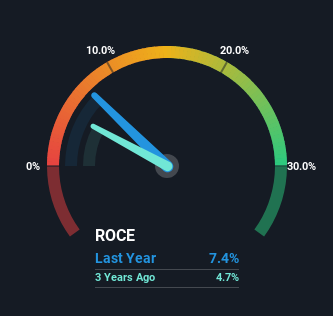- United States
- /
- Healthcare Services
- /
- NasdaqCM:AHCO
Returns On Capital Signal Tricky Times Ahead For AdaptHealth (NASDAQ:AHCO)

There are a few key trends to look for if we want to identify the next multi-bagger. Amongst other things, we'll want to see two things; firstly, a growing return on capital employed (ROCE) and secondly, an expansion in the company's amount of capital employed. This shows us that it's a compounding machine, able to continually reinvest its earnings back into the business and generate higher returns. Having said that, from a first glance at AdaptHealth (NASDAQ:AHCO) we aren't jumping out of our chairs at how returns are trending, but let's have a deeper look.
Return On Capital Employed (ROCE): What Is It?
If you haven't worked with ROCE before, it measures the 'return' (pre-tax profit) a company generates from capital employed in its business. The formula for this calculation on AdaptHealth is:
Return on Capital Employed = Earnings Before Interest and Tax (EBIT) ÷ (Total Assets - Current Liabilities)
0.074 = US$288m ÷ (US$4.5b - US$596m) (Based on the trailing twelve months to June 2024).
So, AdaptHealth has an ROCE of 7.4%. Ultimately, that's a low return and it under-performs the Healthcare industry average of 10%.
See our latest analysis for AdaptHealth

Above you can see how the current ROCE for AdaptHealth compares to its prior returns on capital, but there's only so much you can tell from the past. If you'd like to see what analysts are forecasting going forward, you should check out our free analyst report for AdaptHealth .
How Are Returns Trending?
On the surface, the trend of ROCE at AdaptHealth doesn't inspire confidence. Around five years ago the returns on capital were 17%, but since then they've fallen to 7.4%. On the other hand, the company has been employing more capital without a corresponding improvement in sales in the last year, which could suggest these investments are longer term plays. It may take some time before the company starts to see any change in earnings from these investments.
On a related note, AdaptHealth has decreased its current liabilities to 13% of total assets. So we could link some of this to the decrease in ROCE. Effectively this means their suppliers or short-term creditors are funding less of the business, which reduces some elements of risk. Some would claim this reduces the business' efficiency at generating ROCE since it is now funding more of the operations with its own money.
Our Take On AdaptHealth's ROCE
To conclude, we've found that AdaptHealth is reinvesting in the business, but returns have been falling. And investors appear hesitant that the trends will pick up because the stock has fallen 57% in the last three years. Therefore based on the analysis done in this article, we don't think AdaptHealth has the makings of a multi-bagger.
One more thing to note, we've identified 1 warning sign with AdaptHealth and understanding it should be part of your investment process.
While AdaptHealth isn't earning the highest return, check out this free list of companies that are earning high returns on equity with solid balance sheets.
New: Manage All Your Stock Portfolios in One Place
We've created the ultimate portfolio companion for stock investors, and it's free.
• Connect an unlimited number of Portfolios and see your total in one currency
• Be alerted to new Warning Signs or Risks via email or mobile
• Track the Fair Value of your stocks
Have feedback on this article? Concerned about the content? Get in touch with us directly. Alternatively, email editorial-team (at) simplywallst.com.
This article by Simply Wall St is general in nature. We provide commentary based on historical data and analyst forecasts only using an unbiased methodology and our articles are not intended to be financial advice. It does not constitute a recommendation to buy or sell any stock, and does not take account of your objectives, or your financial situation. We aim to bring you long-term focused analysis driven by fundamental data. Note that our analysis may not factor in the latest price-sensitive company announcements or qualitative material. Simply Wall St has no position in any stocks mentioned.
About NasdaqCM:AHCO
AdaptHealth
Sells home medical equipment (HME), medical supplies, and home and related services in the United States.
Good value with adequate balance sheet.
Similar Companies
Market Insights
Community Narratives



